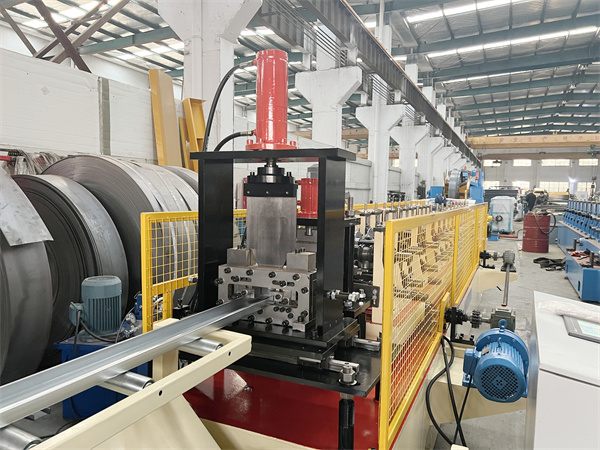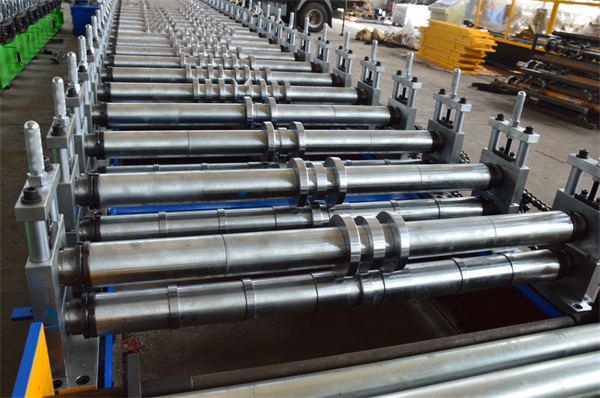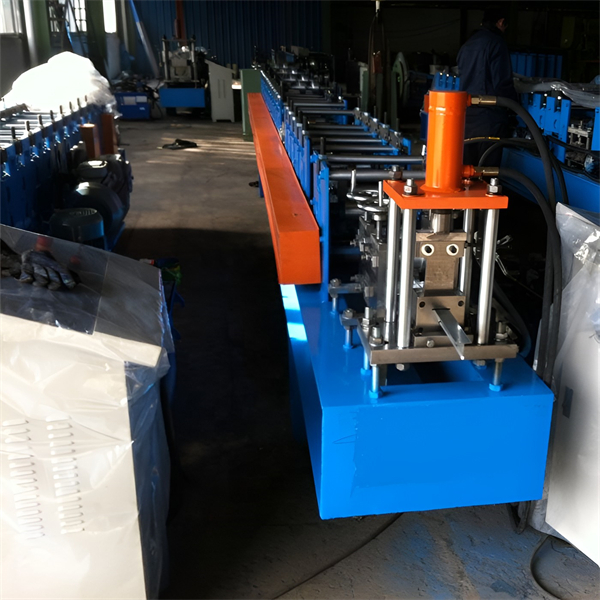1. How does a steel square pipe roll forming machine work?
A steel square pipe roll forming machine is a sophisticated piece of equipment designed to transform flat strips of steel into precisely shaped square pipes. The process involves several steps that collectively create seamless square pipes used in various industries.
1. Material Feeding
The process begins with feeding a flat strip of steel into the machine. This strip serves as the raw material from which the square pipe will be formed.
2. Entry Section
In the entry section of the machine, the steel strip is guided through a set of rollers. These rollers serve to guide the material and ensure its proper alignment as it enters the forming process.
3. Pre-Cutting (Optional)
In some cases, a pre-cutting step might be included to ensure the initial length of the strip is appropriate for the desired pipe length. This step can help optimize material usage and reduce wastage.
4. Roll Forming Stations
The heart of the machine lies in its roll forming stations. These stations consist of a series of rollers that are strategically positioned. As the steel strip passes through each station, the rollers progressively bend and shape the material into the desired square cross-sectional form. Each station contributes to shaping the pipe incrementally.
5. Welding (Optional)
If a continuous square pipe is required, a welding station might be integrated into the machine. This station fuses the edges of the bent strip together to create a seamless pipe. Welding is usually carried out using various methods such as high-frequency induction welding or laser welding.
6. Sizing and Cutting
After the pipe has been formed and potentially welded, it passes through sizing and cutting stations. These stations ensure the pipe’s dimensions meet the desired specifications. Precise cutting mechanisms are employed to trim the pipe to the required length.
7. Final Output
The finished square pipes are then ready for collection. Depending on the machine’s automation capabilities, the pipes might be automatically stacked or fed into subsequent processes.

2. What are the advantages of using steel square pipe roll forming machines?
Steel square pipe roll forming machines have become a cornerstone of modern manufacturing, offering a range of advantages that make them indispensable in various industries. These machines provide efficient, precise, and cost-effective solutions for producing square pipes. Let’s explore some of the key benefits of using steel square pipe roll forming machines:
1. High Efficiency
Roll forming machines are designed for high-speed production. The continuous bending process allows for a steady flow of material, enabling manufacturers to produce square pipes at a rapid pace. This efficiency is particularly valuable for meeting tight production schedules and demands.
2. Precise Shaping
The incremental bending process employed by roll forming machines ensures consistent and precise shaping of square pipes. Each station along the forming line contributes to shaping the material incrementally, resulting in accurate dimensions and square cross-sections. This precision is crucial for industries where dimensional accuracy is paramount.
3. Consistent Dimensions
Unlike some traditional manufacturing methods that might lead to variations in dimensions, roll forming machines provide uniform and consistent pipe dimensions. This consistency is critical for ensuring compatibility and fit within various applications and assemblies.
4. Material Savings
Roll forming machines minimize material wastage due to their efficient shaping process. The gradual bending and forming method means that less material is lost during production. This not only reduces costs associated with material waste but also contributes to sustainability efforts.
5. Flexibility in Design
These machines offer flexibility in producing square pipes of different sizes and thicknesses. Manufacturers can adjust the machine settings to accommodate varying specifications, allowing for a diverse range of products to be produced without the need for major retooling.
6. Reduced Labor Costs
Automated roll forming machines require minimal manual intervention, leading to reduced labor costs. Once the machine is properly set up and calibrated, it can operate continuously with minimal supervision, optimizing productivity.
7. Versatility in Applications
Steel square pipes produced by roll forming machines find applications across numerous industries. They are used in construction for structural support, in automotive manufacturing for frames and chassis components, and even in furniture and agriculture for various load-bearing purposes.
8. Enhanced Surface Finish
The gradual shaping process results in smooth and uniform surfaces on the finished square pipes. This smooth finish can be desirable for applications where aesthetics or reduced friction are important.
9. Minimized Post-Processing
The precise shaping achieved by roll forming machines often reduces the need for extensive post-processing, such as grinding or sanding, which is common with other manufacturing methods. This streamlines the production process and saves both time and additional resources.
10. Longevity and Reliability
Roll forming machines are engineered for durability and reliability. Properly maintained machines can operate efficiently for years, contributing to a consistent production process and minimizing downtime.
3. hat industries utilize steel square pipes produced by these machines?
Steel square pipes produced by roll forming machines are versatile components that find applications across various industries. These pipes, known for their structural integrity and precise dimensions, serve as essential building blocks in a wide range of products and structures. Let’s explore the industries that benefit from the use of steel square pipes:
1. Construction Industry
The construction sector is a primary consumer of steel square pipes. These pipes are used in the construction of buildings, bridges, and other infrastructure projects. They are employed for structural support, framing, and the creation of sturdy frameworks that withstand various loads and stresses.
2. Automotive Manufacturing
In the automotive industry, steel square pipes play a crucial role in the production of vehicle frames, chassis components, and safety structures. Their high strength-to-weight ratio makes them ideal for ensuring the structural integrity and safety of vehicles.
3. Furniture Manufacturing
Steel square pipes are used extensively in the furniture industry to create frames and structures for various types of furniture. From chairs and tables to shelves and racks, these pipes provide the necessary support and stability for furniture designs.
4. Agricultural Equipment
In agriculture, steel square pipes are employed in the construction of equipment such as tractors, plows, and irrigation systems. Their robustness and durability make them well-suited for withstanding the demanding conditions of agricultural operations.
5. Material Handling
Steel square pipes are utilized in the manufacturing of material handling equipment such as conveyor systems, storage racks, and shelving units. These pipes provide the necessary strength and stability to support heavy loads and ensure efficient material movement.
6. Greenhouse Construction
The agriculture industry benefits from steel square pipes in greenhouse construction. These pipes form the structural framework of greenhouses, providing the necessary support for the structure and allowing for controlled environments to cultivate plants.
7. Energy and Utilities
Steel square pipes are used in energy and utility sectors for applications such as creating support structures for power transmission lines, fencing for substations, and frameworks for solar panel installations.
8. Signage and Display
In the signage and display industry, steel square pipes are utilized to create frames for signs, banners, and displays. Their strength and versatility allow for the creation of eye-catching and durable structures.
9. Playground Equipment
Steel square pipes are often used in the construction of playground equipment, providing the necessary support and structure for swings, slides, climbing structures, and other play elements.
10. Infrastructure Projects
Steel square pipes find applications in various infrastructure projects such as the creation of walkways, handrails, and support structures in public spaces, railways, and airports.

4. What factors should be considered when choosing a steel square pipe roll forming machine?
1. Production Speed
Determine the desired production speed that aligns with your output requirements. Different machines have varying processing speeds, so choose a machine that can meet your production targets without compromising on quality.
2. Pipe Dimensions
Consider the range of pipe dimensions you intend to produce. Ensure the machine can handle the specific square pipe sizes you need, both in terms of length and width, without requiring frequent adjustments or reconfigurations.
3. Material Thickness Compatibility
Check the range of steel thicknesses the machine can effectively process. Ensure that the machine is compatible with the gauge of steel you plan to use for your square pipes.
4. Automation Features
Modern roll forming machines often come with various levels of automation. Determine the degree of automation that suits your production environment and level of expertise. Automated features can enhance efficiency and reduce the need for manual intervention.
5. Manufacturer Reputation
Choose a reputable manufacturer known for producing reliable and high-quality roll forming machines. Research customer reviews, testimonials, and the manufacturer’s track record in delivering robust and durable equipment.
6. Customization Options
Flexibility in customization is crucial. Check if the machine allows adjustments to produce square pipes of varying dimensions, thicknesses, and specifications. This adaptability ensures versatility in meeting different project requirements.
7. Maintenance and Support
Consider the ease of maintenance and availability of spare parts. Opt for a machine with a user-friendly design that facilitates routine maintenance tasks. Additionally, ensure the manufacturer offers reliable after-sales support and assistance.
8. Budget Considerations
Understand your budget constraints and find a balance between the features you need and the cost of the machine. While it’s essential not to compromise on quality, choose a machine that offers the best value for your investment.
9. Energy Efficiency
Evaluate the machine’s energy consumption. Energy-efficient machines can lead to cost savings over time and contribute to sustainability efforts.
10. Training and Operator Skill Level
Consider the skill level of your operators and the training required to operate the machine effectively. Choose a machine that aligns with the skill set of your team or provides comprehensive training as part of the package.
11. Future Scalability
Anticipate potential growth in your production needs. Choose a machine that can accommodate increased production requirements in the future without major upgrades or replacements.
12. Safety Features
Ensure the machine adheres to safety standards and is equipped with necessary safety features to protect operators and prevent accidents during operation.
5. How can I maintain a steel square pipe roll forming machine?
Proper maintenance of a steel square pipe roll forming machine is crucial to ensure its longevity, consistent performance, and the quality of the produced square pipes. Regular upkeep helps prevent breakdowns, reduces downtime, and maximizes the return on your investment. Here are some essential maintenance practices to follow:
1. Regular Cleaning
Keep the machine clean by removing dust, debris, and accumulated material. Regular cleaning prevents contaminants from affecting the machine’s moving parts and ensures smooth operation.
2. Lubrication
Apply appropriate lubricants to the machine’s moving components, such as rollers, bearings, and gears. Proper lubrication reduces friction, minimizes wear and tear, and extends the lifespan of these critical parts.
3. Inspect Electrical Components
Regularly inspect the electrical components, including wiring, switches, and sensors. Ensure that all connections are secure and that there are no signs of damage or wear that could lead to electrical issues.
4. Tighten Fasteners
Check and tighten all nuts, bolts, and fasteners. Vibrations from operation can cause them to loosen over time, potentially leading to misalignment or compromised performance.
5. Monitor Belt Tension
If your machine uses belts for power transmission, monitor and adjust their tension as needed. Proper belt tension ensures efficient power transfer and prevents slippage.
6. Check Rollers and Tooling
Inspect the rollers and tooling regularly for signs of wear, damage, or misalignment. Replace worn components promptly to maintain accurate shaping and prevent defects in the square pipes.
7. Alignment
Ensure that the machine’s components are properly aligned. Misalignment can lead to uneven pipe shaping and premature wear of machine parts.
8. Cooling and Ventilation
If your machine has cooling systems, ensure they are functioning correctly. Proper cooling prevents overheating and extends the life of components such as motors and electrical systems.
9. Regular Calibration
Calibrate the machine periodically to maintain accurate dimensions and squareness of the produced pipes. Check and adjust settings as necessary to meet your specifications.
10. Document Maintenance Activities
Maintain a maintenance log that records each maintenance activity, including cleaning, lubrication, inspections, and repairs. This log helps track the machine’s maintenance history and informs future upkeep.
11. Safety Checks
Regularly inspect safety features such as emergency stop buttons, safety guards, and interlock systems. Ensure they are functional and compliant with safety regulations.
12. Professional Servicing
Schedule routine professional servicing by trained technicians. Regular servicing can identify potential issues early, prevent major breakdowns, and address wear and tear that might not be evident during routine inspections.
13. Operator Training
Train machine operators in proper maintenance procedures and safety protocols. Well-trained operators are more likely to notice issues early and perform routine maintenance effectively.

6. Are these machines customizable for different pipe dimensions?
Yes, many steel square pipe roll forming machines are designed with customization in mind, allowing manufacturers to produce square pipes of various dimensions and specifications. This customizability is a significant advantage, as it enables versatility in production and the ability to cater to diverse project requirements. Here’s how these machines can be customized for different pipe dimensions:
1. Adjustable Tooling and Rollers
Roll forming machines often feature adjustable tooling and rollers that can be configured to shape the steel strip into different profiles. By modifying the position and design of these components, operators can achieve specific dimensions and cross-sectional shapes for the square pipes.
2. Quick Changeover
Some machines are equipped with quick changeover mechanisms that facilitate efficient transitions between different pipe dimensions. This feature reduces downtime associated with retooling and setup, allowing for more flexible production scheduling.
3. Computerized Controls
Modern roll forming machines often come with computerized controls and programming interfaces. Operators can input the desired pipe dimensions and other specifications into the control system. The machine then automatically adjusts its settings to produce pipes with the specified dimensions.
4. Multiple Forming Stations
Machines with multiple forming stations offer greater flexibility in achieving various pipe dimensions. Each forming station contributes to shaping the pipe incrementally, allowing for complex profiles and precise dimensions to be achieved.
5. Modular Design
Some roll forming machines feature a modular design that allows for the integration of additional forming stations or tooling modules. This modularity enhances the machine’s adaptability and makes it easier to accommodate different pipe dimensions.
6. Software Configurations
Certain machines come with software that allows operators to create and save different profiles. These profiles can be quickly recalled when switching between different pipe dimensions, streamlining the setup process.
7. Thickness Adjustment
Customizable machines may also offer the ability to adjust for different steel thicknesses. This is important when producing pipes with varying levels of structural integrity.
8. Optional Accessories
Manufacturers often provide optional accessories or attachments that can be added to the machine to accommodate specific production needs. These accessories can enhance the machine’s capability to produce pipes with unique dimensions and features.
9. Consultation with Manufacturer
When considering customization for different pipe dimensions, it’s advisable to consult with the machine manufacturer. They can provide insights into the machine’s capabilities, limitations, and any additional components or adjustments needed to achieve the desired dimensions.
10. Testing and Validation
After making adjustments for different pipe dimensions, it’s essential to perform testing and validation to ensure the machine produces pipes that meet the specified criteria. This ensures consistent quality and accurate dimensions in the final products.
Article Summarization Table
| Step | Question | Article Content Summary |
|---|---|---|
| 2 | How does a steel square pipe roll forming machine work? | Explanation of the working principle and process of steel square pipe roll forming machines. |
| 3 | What are the advantages of using steel square pipe roll forming machines? | Benefits of these machines, including efficiency, precision, and cost savings. |
| 4 | What industries utilize steel square pipes produced by these machines? | Applications of square pipes in various industries and their structural uses. |
| 5 | What factors should be considered when choosing a steel square pipe roll forming machine? | Factors to consider when selecting a machine, such as speed, dimensions, and manufacturer reputation. |
| 6 | How can I maintain a steel square pipe roll forming machine? | Maintenance tips to ensure the machine’s longevity and consistent performance. |
| 7 | Are these machines customizable for different pipe dimensions? | Information on customization options for producing square pipes of varying dimensions. |
Conclusion
Steel square pipe roll forming machines are indispensable tools in the modern manufacturing landscape. Their ability to efficiently produce high-quality square pipes with precision and consistency makes them invaluable across multiple industries. Understanding their operation, benefits, and maintenance is crucial for anyone looking to integrate these machines into their production processes.
FAQ
Q1: What is a steel square pipe roll forming machine?
A steel square pipe roll forming machine is used to create square pipes from flat steel strips through continuous bending.
Q2: How does it work?
The machine shapes steel by passing it through rollers, gradually forming it into a square cross-section.
Q3: What are the benefits?
Benefits include efficiency, precise shaping, consistent dimensions, and reduced material wastage.
Q4: What industries use these pipes?
Industries like construction, automotive, and furniture use these pipes for structural purposes.
Q5: How to choose the right machine?
Consider factors like production speed, dimensions, steel thickness compatibility, and manufacturer reputation.
